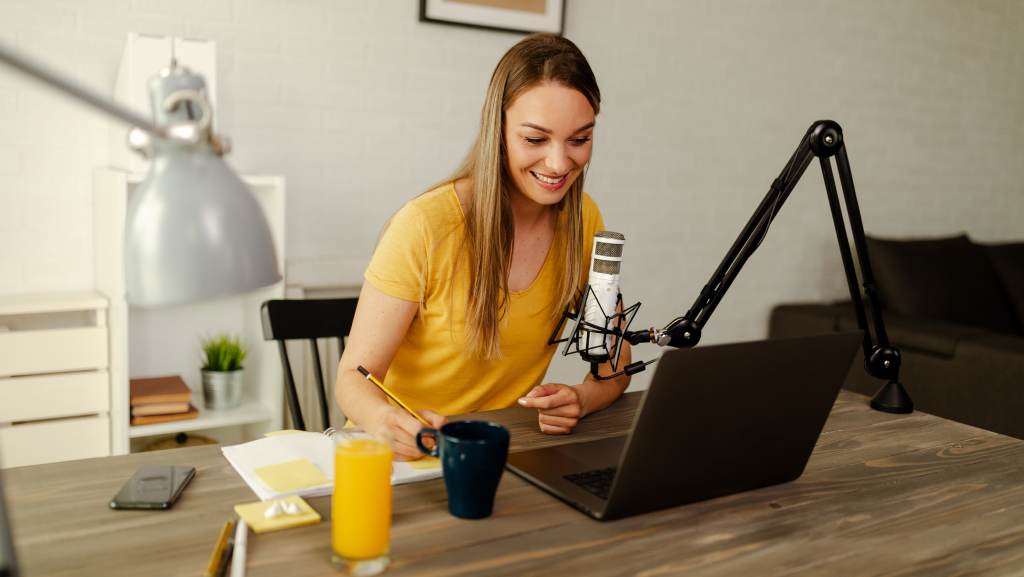A comprehensive guide for transcribing your podcast
On this page:
Podcasting is big business. It’s an industry that’s seen tremendous growth over the past decade. And it doesn’t show any signs of slowing down. In fact, it’s estimated that 2021 will see a 10.1% increase in the number of monthly US podcast listeners. That’s huge when you consider the fact that already more than 60% of US adults between the ages of 18 and 34 listen to a podcast every single month. And 50% of adults aged 35-44 do the same. But it’s not just the US that’s seeing this kind of podcast growth. European nations are seeing similar numbers, with Spain, Ireland, and Sweden all approaching 40% of adults being monthly listeners. And while European podcasters are depending less on advertising revenue and more on other forms of income, the market is strong with potential. This is the reason that so many people are rushing into the podcast space, hoping to strike gold with quality content.
Unfortunately, this means that there’s more competition than ever. But there is a way to distinguish yourself from all of those other podcasters out there. By creating a transcription of your podcast after it’s been recorded, you’ll enjoy a host of valuable benefits. You can use that transcription to boost your site’s SEO score, bringing in more listeners and expanding your reach. You can repurpose content by quickly creating articles out of your transcribed audio content. You can make your show more inclusive, boosting accessibility by providing transcriptions for those with hearing impairments. And you can make it easier than ever to share short, quotable snippets of your podcast on social media.
Before we dig into the nuts and bolts of how to transcribe your podcast, let’s take a brief minute to reflect on all the reasons your podcast needs a transcription.

If you’re like most content creators, your goal is to build an audience that’s passionate about your content. And while creating a transcription of your podcast won’t make you an overnight success all on its own, it is an important tool on your journey.
Many podcasters have a personal website so they can connect with their audience outside of podcasting platforms like Spotify and iTunes. By creating a web presence, embedding your audio podcasts, and including a transcription of the podcast, you’ll increase your visibility and reach exponentially. As you create more podcasts and upload them and their transcriptions, search engines will have tons of keywords to discover. Then, they’ll send more people your way so they can engage with your content.
Transcriptions also give your audience multiple ways to access your content. If they prefer reading or find themselves in an environment where listening is difficult, they can check out the written transcription of your podcast. If they’re commuting and need to keep their eyes on the road, they can listen to your podcast through their favorite app. And if they enjoy the visual appeal of YouTube, they can watch a video of your podcast that features related images. This is a great way to make your content as accessible. And it’s all possible with the help of reliable podcast transcriptions.
In addition to all of this, by housing your podcasts and their transcriptions on an independent website, you can give your audience the ability to quickly search through hours of podcast content for specific words and phrases. Your listeners will love the fact that they can find exactly what they need, even if they only remember a brief comment.
Finally, transcriptions give you the ability to make your content quotable for your audience and for the general public. With a transcription in hand, you can pull out short, quotable snippets and post them on your social media accounts or even create shareable quote pictures.
Transcribing your podcast is worth the effort. However, if you’ve never done it before, you might wonder how difficult it is. If you’re like most busy people today, you don’t have time to create a transcription manually. And your only experience with automatically generated subtitles may be less than stellar. So, how can you create a reliable transcription of your podcast without losing your mind? Read on to find out.

Scriptix makes it easy to enjoy the benefits of a podcast transcription without losing your mind. Our advanced speech to text technology even has the ability to correctly transcribe jargon, heavy accents, and more. Simply follow these steps and we’ll help you turn all of your podcasts into understandable text that can be used in numerous ways…
Automatically transcribe your podcast with Scriptix
Transcribing your podcast with Scriptix is a snap.
First, you’ll want to locate your podcast’s audio file and upload it to the Scriptix platform. Within minutes, our system will begin processing it, analyzing every syllable with our unique Speech Recognition Engine. Then, your audio’s sound will be synced with the correct words using a reliable lexicon model. Once this step is complete, our platform will begin converting your sound into readable text.
Our platform’s language model will structure the results of your transcription and deliver a raw text file that includes important metadata (a confidence score, a speaker ID, and a timestamp) for each word.
You may be wondering, “Is that really all it takes?”
Yes. Having your podcast automatically transcribed with Scriptix really is that simple. Though you aren’t quite ready to post it online or use it to add subtitles to a podcast video. A couple of steps still remain…
Edit your transcription for maximum readability
Before you export your file, you’ll want to go through and edit your transcription for maximum readability. We’ve worked hard to ensure that Scriptix provides the most accurate automatically-generated transcriptions possible. So, it’s important to go through your file and look for incorrect words, misplaced punctuation, and poor formatting. And if you’re going to be using this file to create subtitles for a podcast video, you’ll also want to check the timecodes to make sure that everything lines up perfectly.
Export your file for further use
Once you’ve gotten your transcript edited to perfection, it’s time to export it. Simply choose whether you want it to be exported as a transcription or a subtitle file and Scriptix will do the rest. Within seconds, you’ll have a high-quality file that you can use in a variety of creative and helpful ways, including the following…
More people than ever are listening to podcasts. But there’s an entirely different demographic that’s consuming content via video platforms like YouTube and Vimeo. Plus, turning your audio content into videos means that you’ll be more visible by all the most popular search engines. And with transcriptions of your videos, you can even add a search feature to your website so visitors can pinpoint specific words and phrases within an entire archive of videos. By converting your audio podcast into a video, you’ll be able to multiply your reach and increase your impact.
But perhaps the best thing about turning your audio podcast into a video is the fact that it’s easy and cheap to do. You won’t need any expensive software or other high-tech gadgets. In fact, you can create a compelling video version of your podcast in very little time and for zero cost. So, what are you waiting on?
Choose a video content strategy
Once you’ve decided to use your podcasts to create videos, you’ll want to decide on your video content strategy. Some content creators record themselves and any guests as they’re doing the podcast. This gives viewers a first-hand look into your studio and allows them to put a voice to a face. Then, you can use video editing software (there are free and paid varieties) to add an intro, lower third graphics, and more.
If you’d prefer not to be seen on your podcast video, you can always use static images instead. In fact, PowerPoint gives you the ability to create background images for your podcast and to edit the whole presentation as a video file that you can upload.
There are pros and cons to both video content strategies. Deciding on which route to take will largely depend on how comfortable you are behind a camera, what your audience is familiar with, and how much time you want to spend on editing. But no matter which path you take, creating your video is only the first step to getting the most out of a video version of your podcast.

Add subtitles to your video podcasts
Once your video is complete, you’ll be able to use the transcription created by our platform to add subtitles to it. Since our transcriptions include the timecode of each word spoken, you can be sure to get subtitles that match the audio and video perfectly. By adding subtitles to your video podcasts, you’ll empower your audience to consume your content wherever they find themselves, including noisy environments and places where silence is required.Reach foreign language viewers with subtitles
If you’re a podcaster who’s interested in reaching the largest audience possible, subtitles can help. By offering viewers subtitles in a range of foreign languages, you’ll make it possible for your podcast to be heard and shared all around the world. And with Scriptix, getting those foreign language subtitles is a snap. All you’ll need to do is have your podcast transcribed, then hire someone who can translate it into any language you choose. Then, you can use that translation to easily add foreign language subtitles, instantly increasing your potential reach by millions.Having your podcast transcribed also gives you the ability to repurpose spoken content as blogs and articles. This is the case whether your podcast only includes you speaking or it uses a dialogue format. Simply have a transcription of your podcast created with Scriptix, then load that transcription into your favorite word processor. Since it began as spoken content, you may have to do some editing and cleaning up before it’s ready for publication. But the bulk of the work will already be done.
Once you’ve gotten your transcription edited so it reads well, you can use it in several different ways. For example, you may want to use it as a standalone blog post that you can upload on your personal site. Or you might consider putting it on Medium or a similar content aggregator. Likewise, you may even want to consider submitting it to other sites, or even magazines. Wherever you get it published, you can have a link to your site or podcast in the included bio line. This will allow people to find the rest of your content.
If you haven’t been taking advantage of a transcription service like Scriptix for your podcast, it’s time. It’s never been easier to enhance your content, grow your audience, and beat the competition.

While some people may think that the podcasting craze has died down, the reality is that it’s not even reached its peak. Recent estimates say that monthly podcast listeners will increase by 10% over the next year. So there’s never been a better time to leverage the power of podcasting for your platform.
Having your podcast transcribed can help in several different ways. It allows you to be found more easily via search engines, it boosts accessibility, and it makes it easier to share individual quotes and snippets. Plus, it allows you to repurpose content in a variety of valuable ways.
Scriptix makes it simple to have your podcast transcribed. Simply upload the audio file to our system and it will automatically generate a transcription. Then, you’ll want to go through and edit it, ensuring there are no hiccups or others issues. Finally, you can use it however you want – from creating subtitles for a video version of your podcast to repurposing it as a blog or article.
You’ve got several options if you’re looking to turn your podcast into a video. You can film yourself while you’re recording and use that as the basis for your video. Or you can use software to put together a slideshow of still images that go with your podcast.
Having your podcast transcribed allows you to repurpose it in a variety of ways. You can turn it into a video that includes subtitles, enabling your audience to watch it even when they can’t turn their device’s volume up. Or you can put it through a few rounds of editing and upload it as a blog post or article. By doing this, you’ll be sure to reach your audience no matter how they enjoy their content – whether listening, watching, or reading.
